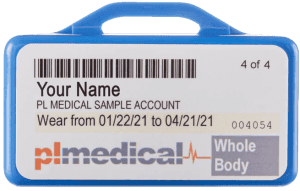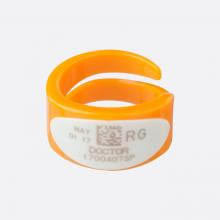Numerous occupations involve the potential risk of exposure to radiation and it’s essential for workers to be mindful of this. If there is exposure to radiation, the responsibility for damage caused by radiation in the workplace is most often assigned to the employer. To monitor potential radiation exposure in the workplace, many employees in industries like healthcare, government, and educational research labs wear x-ray dosimeter badges called dosimeters to protect their health while working. But what exactly does a dosimeter do? Continue reading to learn more about dosimeters and how to use one properly.
What is a Dosimeter?
A dosimeter, or radiation badge, is a small portable instrument (such as a film badge, thermoluminescent dosimeter [TLD], optically stimulated luminescence [OSL] or pocket dosimeter) for measuring and recording the total accumulated dose of ionizing radiation a person receives. Dosimeters do not protect against the radiation itself but rather measure and alert working professionals if the radiation they were exposed to is considered dangerous. Dosimeter badges ensure that working professionals are protected from harmful doses of radiation while frequently exposed to them over time.
What Does a Dosimeter Measure?
A dosimeter measures if the individual was exposed to radiation, what type of radiation the exposure was, and the amount/dosage of radiation the person’s body received. The measuring period of a dosimeter can vary between monthly, bi-monthly, quarterly, or semi-annual timeframes. While small amounts of radiation exposure are common (even outside of the workplace), the more exposure you have to radiation, the more likely it is to become dangerous over time. The PL Medical staff will review any report containing results outside of acceptable limits and the customer will be notified immediately so that appropriate actions can be taken.
For more information about occupational dose limits, download our guide here.
What Types of Dosimeters Are Available?
Different dosimeters are used depending on the radiation exposure and/or occupation. Some dosimeters can be held like a radioisotope identification device (RIID). PL Medical offers dosimeters that can be worn called OSL whole body dosimeters. These dosimeter badges are meant to be worn by the individual they are assigned to. Our dosimeters can withstand daily activities and are created to be used for up to one year. We ensure our dosimeters are easy to wear, easy to read and identify, and durable for many daily tasks in various industries. Learn more about the features of our badges below:

Badges
Our radiation badges are small, lightweight, and clip easily to the outside of clothing. Each badge is punch-coded and bar-coded with an ID number for identification and tracking for one individual.
- Our OSL dosimeter is a four-element dosimeter with a minimal reportable dose of 1 mrem (.10 mSv)
- Energies Measured: X-Ray, Beta, Gamma. Beta (76 keV—5 MeV).
- Photon (20 keV—6 MeV)
- Reporting Periods: Monthly, Bi-Monthly, Quarterly
- Minimum reportable dose: 10mrem, 0.10 mSv
- Wear periods from monthly to 1 year
Rings
Rings are easy to adjust to wear on any finger for any hand, and while wearing protective hand coverings. Just like our badges, each ring is designed to be used and monitored for one individual.
- Our extremity dosimeter is a Single Element Dosimeter specifically designed for extremities
- Energies Measured: X-Ray, Betas and Photons. Beta (>200keV). Photon (> 15keV)
- Minimum reportable dose: 10mrem, 0.10 mSv
- Wear periods from monthly to 1 year
When and Where Do You Use a Dosimeter?
Our dosimeters are meant to be worn daily. If it is a badge, it needs to be worn on the front of your body in the main area of your torso (between your neck and your waist). Make sure it is not covered by any lead shielding protection and the badge with the detector side (punch code and barcode) is facing outward. Rings will need to be worn on the hand that is interacting with the radioactivity under protective hand covering. Similar to the badge, the detector side of the ring will need to be faced outward. When not in use, dosimeters need to be stored in a secure area of the workplace with little to no radiation, and cannot leave the worksite.
Interested in Dosimetry Services?
PL Medical’s dosimetry program is known for providing technology-leading OSL dosimeters to implement and ensure a successful radiation safety program that meets state and federal regulations. To learn more about PL Medical’s dosimetry services, get in touch with us!

